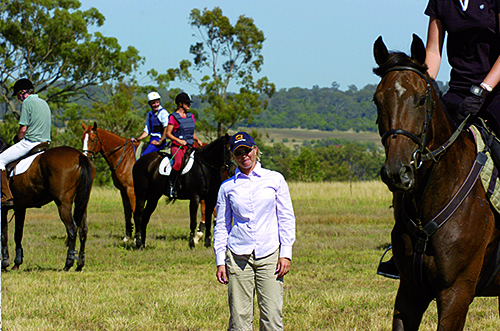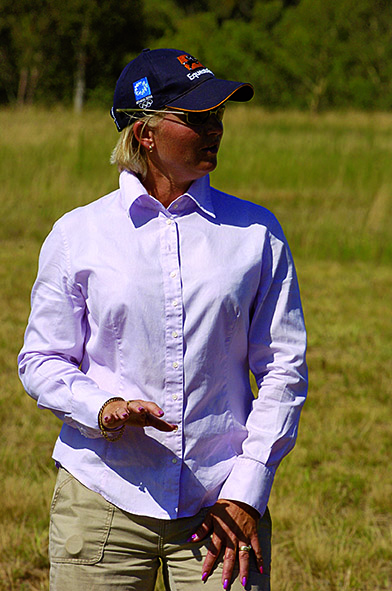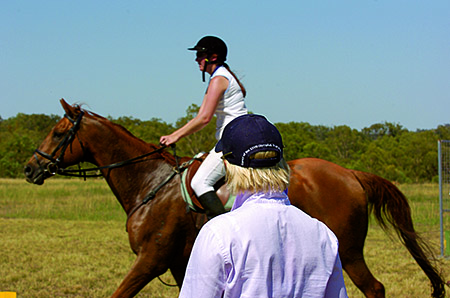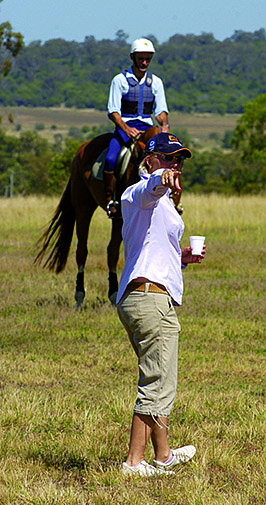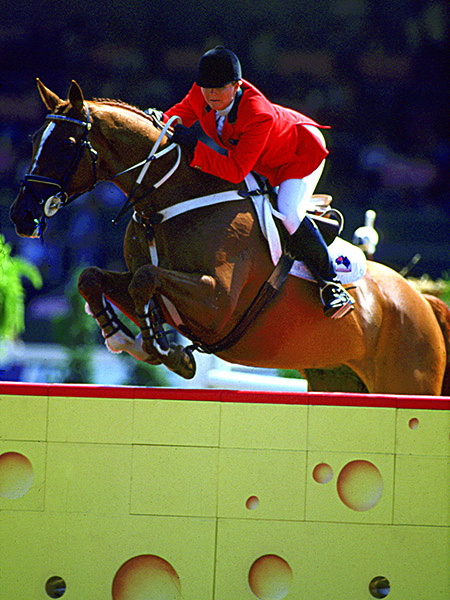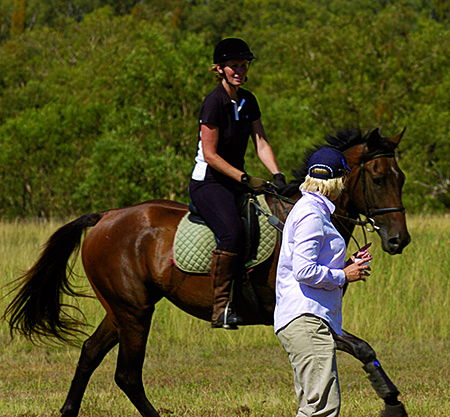Story – Chris Hector & Photos – Roz Neave
It must be confessed that Michelle Lang’s showjumping group at the Warwick School looks just a tiny bit scary. There is a real mixture of horses and riders in there, and some of the horses are on the emerald side of green, ‘it’s his first time out of the paddock,’ splutters one rider as he careers past, while the chestnut with all the chrome is trying to get its head sufficiently close to the earth to mount a serious buck.
Michelle grins and gets on with the job – she’s a Queensland girl; she can remember when she was a little rough around the edges…
“When I first started jumping, I had a really good horse, Odds On. My dad thought he had potential, so he sent me away to George Sanna’s – I’m sure George and Rod and John were saying ‘Oh this is such a good horse, and she is SO feral. Which was the case with my bright red bow in my hair and my bright red saddlecloth. It was great down there, and they did a lot for my riding.”
Did you have an instructor as you were growing up in Queensland?
“I did have a dressage trainer when I was really young. Mum was quite into that and she arranged for me to go to Gay Richardson. Then I swung over to the eventing scene for a while, and we had a full cross-country course at our place and ran events. Then I thought I might give the showjumping a go… And that’s where I landed.”
Michelle’s showjumping instruction is what has – thankfully – become the Australian orthodoxy: “While they want to wobble and duck, we want them very straight. Don’t look down, look ahead. Keep your hand lower, as soon as your hand gets up, he gets a bit fragile. A low hand and smooth, low but not blocked and rigid, soft and low. Make him trot softly over the pole quietly, softly, he must wait. Keep the same rhythm, he wants to move up, keep it nice and soft in the trot, and hopefully he’ll stay that way in the canter.”
“Now let’s canter a circle and quietly pop through these cross rails in a steady four. Three! That was way too big – if you go in like a hillbilly, you will land like a hillbilly. ORGANIZE.”
“At the end of the day it all goes back to basic principles. Paying attention to detail. While the horses are all different, they still have to keep them straight. They still have to keep them balanced, still have to keep them controlled. If they are doing it well over a pole on the ground, they should be able to do it at a metre ten / twenty.”
“It’s the beginning of the season, and everyone is a bit wild and woolly and has to be pulled into gear.”
And if the riders weren’t getting the message, Michelle made it very clear when she wasn’t impressed: “Yucko. Do it again, and no little princess sitting up there. Try not to shift your body weight. Soften and give on the release. Keep the rhythm, keep the straightness.”
And so it went, horse after horse, rider after rider, always that same clear message, which is not surprising for a rider who has studied with trainers like Rod Brown, George Sanna, and more recently Jamie Coman:
“I like to think my approach is classical, I like to keep it simple because we are dealing with Thoroughbreds – and I much prefer the Thoroughbreds to the Warmbloods. The Thoroughbreds need a much softer feel, I hope it is a classical feel.”
Certainly it was a Thoroughbred that put Michelle on the map in a big way. The handsome chestnut, Odds On, was an instant star with his blonde teenage rider.
Where did you find Odds On – he was one of those once in a lifetime horses?
“We have a jump club up here at Mt Gravatt, and one of the racehorse ladies had him out, popping around in an intro group. I loved him from day one. I tried to buy him and she said ‘he’s not for sale’. Then maybe a month later he was for sale, so we bought him. I was very happy to be there at the right time.”
Michelle and Odds On…
How old were you when you hit the World Cup scene?
“I was nineteen when I did my first season of World Cups, and I won a World Cup with him that season. It was great.”
Is it hard when your first real horse has been such a super machine, is it hard to find a second one?
“Yes it is hard finding the second horse, but I was fortunate enough, I had Double Up, who I think was a much better horse. Maybe if I had Odds On now it would be different, I was so naïve when I had him, it’s hard to compare, but I do have a soft spot for Double Up.”
Where did you find him?
“Brett Edwards, who used to own True Colours, had him as a two year old racehorse. I actually used to feed him; I didn’t take a lot of notice, he windsucked and had a parrot mouth. Tony Priestley bought him and sold him on to me for $3000 – he was a really really nice horse. They were both well bred, Odds On, by Sir Tristram, Double Up by Ivor Prince, the same sire as Vo Rogue. Finding the third… that’s a challenge, I think I’ve got a third one but it has been very very hard. I think Serenade will be the one, he’s another Thoroughbred, very scopy, very careful, and hopefully he is everything I need. Paula Hamood started him off. She did two seasons with him; he had a couple of starts in C grade before I bought him. He is nearly B grade now, I have only had him five months, he is a good horse.”
You have a stud and a training operation?
“It is a bit of a mixture. We have the racehorses as well, my uncle and my dad are right into racehorses – we do pre-training and breaking, then we have the stud side of it, we stand the Warmblood, Falkrich, and we like to cross him over the Thoroughbred mares, that gives us jumpers, but also eventers. Simone Kann has a few of his progeny, Rebel Morrow has just bred one.”
Rebel says you have helped her with her showjumping – is it different working with eventing riders?
“It is very good working with Rebel. She has a very good natural feel. She said, ‘I having a lot of trouble, I get really really nervous and I am getting a lot of time faults.’ So she came up and worked and based with Simone, and I took over from there. She was great to teach.”
But it is a different task when you have to create that shorter more collected showjumping canter after you have run them around a cross-country course and opened them up a little?
“With the gear they use in showjumping now, with breakaway cups, then the eventing horses need to be that bit sharper so it goes back to getting them on their hocks, and keeping them more consistent and balanced, and getting the jump elevated. We just can’t get away with rubbing these days, and it is way more technical. They have to be lot more careful, and produced more.”
Do you do a lot of teaching?
“I don’t do so much showjumping teaching in Queensland – the EFA want me to, but I am flat out with what I do. I do a lot of eventers in Queensland. I’d like to do more showjumpers, it is just finding the time.”
Do you think the Thoroughbreds can still cut it in international showjumping?
“We have this debate all the time. Being a pro-Thoroughbred person, and having had two really good Thoroughbreds, makes me a bit biased, but my horse, Double Up held his own at the World Championships in Jerez. If I had trained him over the water, I would have had a faultless round on the first day in the speed class. We had two down the second day, but he jumped super. I think if you have a special Thoroughbred they are really talented, but the Warmbloods are just fantastic as well.”
Do you still have that ambition to get back to another WEG or an Olympic Games?
“It’s funny, I go through stages. One minute I am really keen to get there, this new horse is fantastic, then it is so disappointing doing the shows, they are such a let down – it’s hard to keep focussed and enthused. When you have the big picture in front of you, I suppose that is what keeps you going. Having been there twice it is hard to say, ‘right I am going to make it happen again’. You’ve got to get a plan, and get organized. But I have a plan in place and I just hope it works.”
This article originally appeared in the August 2005 issue of The Horse Magazine




